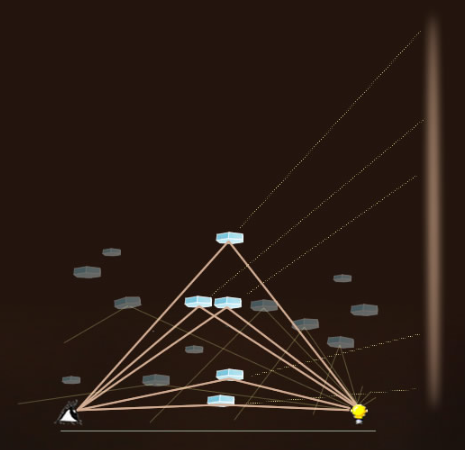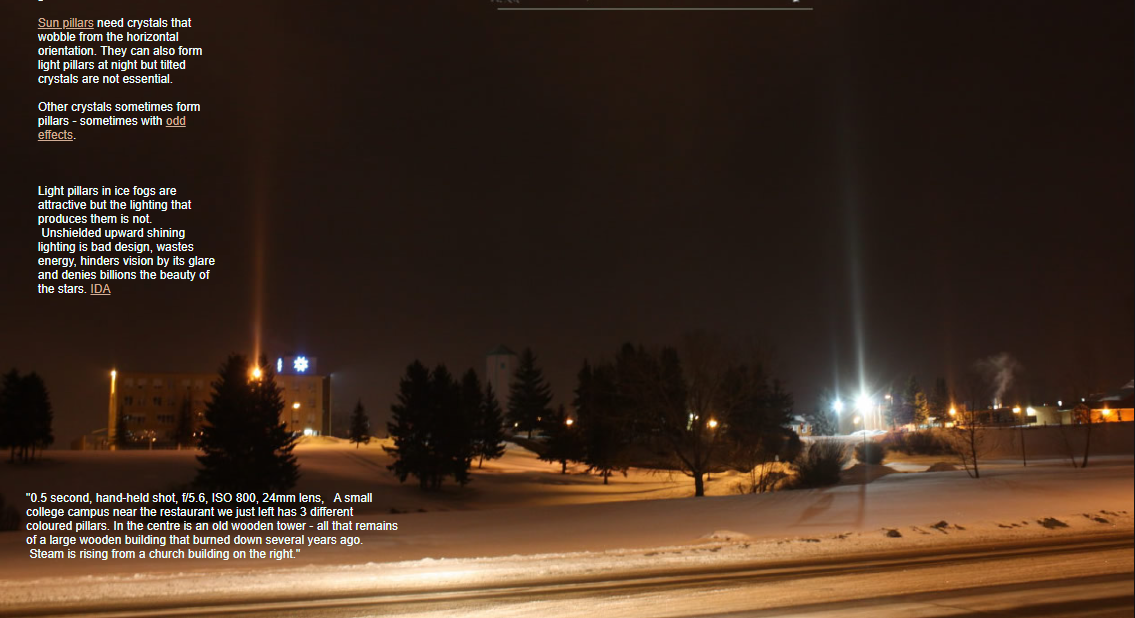OPOD - Calgary Pillars
OPOD - Calgary Pillars: A Captivating Display of Atmospheric Optics
Have you ever witnessed a mesmerizing display of light pillars illuminating the night sky? Calgary, Alberta recently experienced an extraordinary occurrence of these captivating atmospheric phenomena. Amidst a spell of unusually cold temperatures in February and March, residents were treated to a breathtaking spectacle known as light pillars. These pillars, formed by hexagonal plate-shaped ice crystals, adorned the city's sodium and mercury vapor lights, creating a truly enchanting sight.
Light pillars are typically generated by ice crystals found in low-lying clouds or ice fogs near the ground. The slow descent of these crystals, only a few millimeters per second, relative to the local air currents, plays a crucial role in their formation. As they drift downwards, an aerodynamic drag aligns them with their large hexagonal faces almost horizontally. These faces then act as mirrors, reflecting and redirecting light from ground-based lamps back towards the Earth's surface, giving rise to the stunning vertical columns of light.
While light pillars are most commonly observed during the nighttime, sun pillars can also form during the day. However, unlike light pillars, sun pillars require crystals that wobble from their horizontal orientation. The tilted crystals enable the sun's rays to create vertical columns of light. It is worth noting that although tilted crystals are not essential for light pillar formation at night, they can still contribute to their occurrence.
Interestingly, light pillars are not solely limited to ice crystals. Other types of crystals can also give rise to these awe-inspiring atmospheric displays, sometimes resulting in peculiar effects. However, it is the formation of light pillars in ice fogs that truly captivates our attention. The beauty of these phenomena is undeniable, yet the lighting systems responsible for their creation are often poorly designed. Unshielded upward-shining lights not only waste energy but also create unnecessary glare that impairs visibility and obscures the breathtaking beauty of the starry night sky.
To capture the ethereal beauty of light pillars, talented photographers like Larry McNish have immortalized these fleeting moments. McNish's stunning photographs of light pillars in Calgary provide a glimpse into the enchanting world of atmospheric optics. Through his lens, we witness the interplay of light and ice crystals, resulting in a visual spectacle that leaves us in awe of nature's wonders.
The illusionary nature of light pillars adds to their allure. As we gaze upon these vertical beams of light seemingly extending into the heavens, it is important to remember that they are merely illusions. There are no physical pillars suspended in space, nor any upward beams of light. Instead, the millions of glints created by the ice crystals reflect the light rays towards our eyes, conjuring the illusion of vertical pillars over the light sources.
In conclusion, Calgary's encounter with light pillars serves as a reminder of the enchanting phenomena that occur within our atmosphere. These mesmerizing displays, created by ice crystals in low clouds or ice fogs, offer a captivating blend of science and beauty. As we appreciate the magic of light pillars, let us also consider the importance of responsible lighting design to preserve the natural splendor of our night skies.

Light Pillars, Calgary, Alberta
Imaged by Larry McNish (Calgary Center RASC).
"Calgary has been experiencing one of the coldest run of February and March temperatures in recent memory. After midnight on March 5 at -20 C, with a light shower of fine falling ice crystals (needle-like) in the air and almost no wind, we spotted these light pillars on just about every sodium and mercury vapour light in the area.
The top is a tripod shot, 1.3 second, f/5.6, ISO 800, 42mm lens. Sodium streetlights on Sunvalley Blvd. .Canon EOS Digital Rebel XSi.."
©Larry McNish, shown with permission
Light pillars are usually produced by hexagonal plate-shaped ice crystals in low cloud or in ice fogs at ground level.
The crystals drift very slowly downwards (only a few mm/s) relative to the direction of local air currents. They are not necessarily falling towards the ground.
The drift motion sets up an aerodynamic drag that aligns them with their large hexagonal faces nearly horizontal.
The large faces act as mirrors and glint light from lamps on the ground back downwards.
Sun pillars need crystals that wobble from the horizontal orientation. They can also form light pillars at night but tilted crystals are not essential.
Other crystals sometimes form pillars - sometimes with odd effects.
Light pillars in ice fogs are attractive but the lighting that produces them is not. Unshielded upward shining lighting is bad design, wastes energy, hinders vision by its glare and denies billions the beauty of the stars. IDA
"0.5 second, hand-held shot, f/5.6, ISO 800, 24mm lens, A small college campus near the restaurant we just left has 3 different coloured pillars. In the centre is an old wooden tower - all that remains of a large wooden building that burned down several years ago. Steam is rising from a church building on the right."

Crystals roughly half way to the light reflect its rays towards the eye.
The millions of glints appear to form a vertical pillar over the light.
This is purely an illusion, there is no pillar located anywhere in space and no upward beam of light.
In this sense all halos are illusions!

Note: this article has been automatically converted from the old site and may not appear as intended. You can find the original article here.
Reference Atmospheric Optics
If you use any of the definitions, information, or data presented on Atmospheric Optics, please copy the link or reference below to properly credit us as the reference source. Thank you!
-
<a href="https://atoptics.co.uk/blog/opod-calgary-pillars/">OPOD - Calgary Pillars</a>
-
"OPOD - Calgary Pillars". Atmospheric Optics. Accessed on November 26, 2024. https://atoptics.co.uk/blog/opod-calgary-pillars/.
-
"OPOD - Calgary Pillars". Atmospheric Optics, https://atoptics.co.uk/blog/opod-calgary-pillars/. Accessed 26 November, 2024
-
OPOD - Calgary Pillars. Atmospheric Optics. Retrieved from https://atoptics.co.uk/blog/opod-calgary-pillars/.